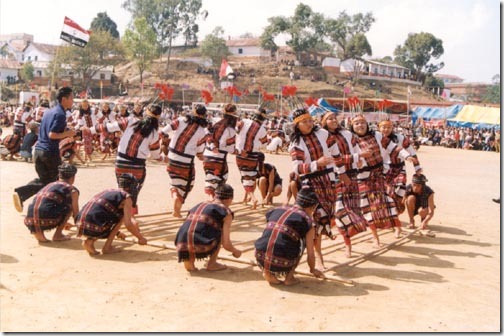By Nava Thakuria
It was a historic decision of the Assam State Forest Department to burn down the stored rhino horns in its custody, as the department wanted to spread the message that horns of endangered rhinoceros do not have any aphrodisiac value.
The proper awareness is expected to help the mission to save the one-horned rhinos from the clutches of notorious poachers.
But it simply did not go smoothly--rather it opened a Pandora's Box as the environmental activists demanded more transparency in the process. The issue came alive in a recent public consultation in Guwahati, where the Indian Union minister of state for environment and forests, Jairam Ramesh was present.
Raising the issue of rhino horns in the meeting, environmental activist Soumyadeep Datta demanded that the horns, readied for disposing of, should be probed with a transparent forensic test. The Nature's Beckon director pointed out that without this precaution, some corrupt officials might take the opportunity to replace a few real horns with fake items and then smuggle those in to the illegal international market.
It is mentionable that the State forest department decided to destroy all stored rhino horns and that they told it to the media. The department informed the media that it has 1,571 rhino horns lying in the lockers of various treasury offices in Assam. It argued that those horns can not be sold in the market as India adopted the Wildlife Protection Act in 1972. The State chief wildlife conservator S. Chand confirmed the news adding that they have taken all precautions regarding the process in respect of wildlife laws of India and also international guidelines.
Called black ivory, the rhino horn is prized as an aphrodisiac, selling for thousands of dollars per kilogram. A single horn can fetch as much as $40,000. The heavy animal enjoys great sexual power, as its mating time is not less than 45 minutes (quite higher than any other animal). Many people believe that one can achieve the same sexual power with the help of rhino horns. They consider the rhino horns as another kind of traditional Viagra.
The horns are also believed to have medicinal values. Traditional Chinese medicine demands rhino horns, which is believed to cure fever and stomach ailments. China, Taiwan, Thailand, South Korea and the Middle East are known to be huge markets for illegal trading of rhino horns. Rising incomes across Asia mean that the demand for powdered rhino horn is on the increase.
Ranjan Talukder, a Guwahati-based veterinarian, says that's nonsense. "It is nothing but superstition," he said in an interview. "The horns are nothing but compact masses of agglutinated hair and rhinos use them for defense against other animals. There is no scientific analysis that the rhino horn powder could stimulate human sex."
A census in 1984 showed that the Kaziranga National Park had 1,080 rhinos. The number was increased by 1069 in another census during 1991. The census in 1999 provided a more optimistic result as the number of rhinos soared to 1,552. The last census in 2006 revealed the number of rhinos were as high as 1,855 in the park.
It should be mentioned that many pressure groups in Assam have been demanding a high level enquiry on rhino poaching and also the originality of horns which are under the possession of the forest department. The All Assam Students Union, an active and influential students' body took out various protest programmes on the issue during the last few years.
The AASU was followed by Nature's Beckon and Journalists' Forum in Assam to raise voices against the corrupt forest officials. The activists of both organizations insisted that the Assam government led by Tarun Gogoi should allow for a Central Bureau of Investigation probe on the stock of wildlife parts in the custody of the forest department as well as about the poaching of rhinos, elephants, tigers and leopards in Assam. They argue that some wildlife organs (like rhino horn, ivory, skins of tigers and leopards) had already made way to the illegal international market from the custody of forest authority employees themselves.
Meanwhile, following the sustained hue and cry among wildlife lovers inside and outside Assam, where the media has also consistently supported the move for the preservation of the rhinos and remained critical against the governmental agencies, the State authority admitted that they had no objection against any high level probe into the mater.
"We have no reservation against a CBI enquiry into the matter of increasing cases of rhino poaching in Kaziranga National Park," Rockybul Hussain, Assam forest and environment minister stated three years back. Soumyadeep Datta also claimed that the State forest department was itself involved with the illegal trade of rhino horns until the eighties. "We have authentic information that the Assam forest department had sold more than 300 rhino horns even after India adopted the wildlife protection act in 1972. We can give the relevant statistics of the sold rhino horns in details as 29 (during 1971-72), 13 (1972-73), 19 (1973-74), 40 (1974-75), 18 (1975-76), 27 (1976-78), 42 (1977-78), 63 (1978-79), 63 (1978-79), 61 (1979-80)," Datta disclosed. He added, "We suspect that a large share of the wildlife parts, which are being sold in the international markets, made way from the forest department's stock due to the manipulation and corrupt practices of some dishonest forest officials. So we demanded the CBI probe on the stock of animal parts in the custody of Assam forest department, as it is assumed that some precious parts of rhinos, elephants, tigers and leopards had gone for international markets from the official stock of the department."
The demand for a CBI probe into the killings of rhinos was also highlighted during a Nagorik Sobha (citizens' meeting) on February 13, 2008, which was organized by the Journalists' Forum, Assam. Concern for the rhinos was also expressed by a group of non-resident Assamese (Indians), who joined the chorus to save the rhinos. The Friends of Assam & Seven Sisters (FASS) supported the demand for a credible and high level enquiry into the ongoing killings of the precious animals. But even after escalating public resentments, the state government remained silent on the issue. The chief minister Gogoi, who is otherwise outspoken, continued to avoid the issue of CBI enquiry while talking to the media. The state forest minister has also covered up his face.
The Journalists' Forum once again raised the issue in the public consultation meeting on June 11 in front of the central minister Jairam Ramesh. The Forum president Rupam Barua expressed his resentment that the government was not serious about the probe and subsequently supported the demand for a transparent forensic test of the rhino horns before burning or disposing off.
 Nava Thakuria is a Guwahati, Northeast India based independent journalist and contributes to various media outlets throughout the world. Contact him at navathakuria@yahoo.com
Nava Thakuria is a Guwahati, Northeast India based independent journalist and contributes to various media outlets throughout the world. Contact him at navathakuria@yahoo.com




 “This peace march is to address the state and the civil society, and tell them that we must engage in non-violence,” says Malayalam litterateur, Prof Sara Joseph, one of the 17 activists who participated in the Hind Swaraj Peace March, which travelled from Cherthala in Kerala — Joseph’s home state — all the way to the north-eastern state of Manipur from May 8 to 23. Their inspiration: peace activist Irom Sharmila (38) from Manipur.
“This peace march is to address the state and the civil society, and tell them that we must engage in non-violence,” says Malayalam litterateur, Prof Sara Joseph, one of the 17 activists who participated in the Hind Swaraj Peace March, which travelled from Cherthala in Kerala — Joseph’s home state — all the way to the north-eastern state of Manipur from May 8 to 23. Their inspiration: peace activist Irom Sharmila (38) from Manipur.  Nava Thakuria is a Guwahati, Northeast India based independent journalist and contributes to various media outlets throughout the world. Contact him at navathakuria@yahoo.com
Nava Thakuria is a Guwahati, Northeast India based independent journalist and contributes to various media outlets throughout the world. Contact him at navathakuria@yahoo.com


 Former Assam CM Prafulla Kumar Mahanta tells KUNAL MAJUMDER that Tarun Gogoi is raking up old cases to hide current Congress scams
Former Assam CM Prafulla Kumar Mahanta tells KUNAL MAJUMDER that Tarun Gogoi is raking up old cases to hide current Congress scams

